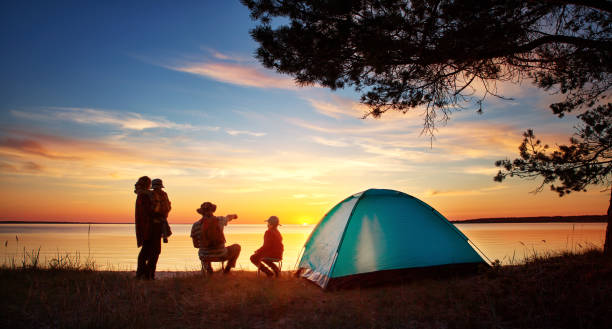Camping is a beloved outdoor activity that allows us to reconnect with nature and create lasting memories. However, the enjoyment of your camping trip can be significantly impacted by how well you organize your camping gear. Proper organization not only saves time and reduces stress but also ensures that you have everything you need at your fingertips when you need it most.
In this comprehensive guide, we’ll explore various strategies and techniques for organizing your camping gear, from storage solutions to packing tips, helping you make the most of your outdoor adventures.
The Importance of Organizing Camping Gear
Efficiency and Time-Saving
One of the primary benefits of organizing your camping gear is the increased efficiency and time-saving it provides. When your equipment is well-organized, you can quickly locate and access items, reducing setup time and allowing you to spend more time enjoying your surroundings. This efficiency is particularly crucial when setting up camp in challenging weather conditions or with limited daylight.
Reduced Stress and Improved Experience
A well-organized camping setup can significantly reduce stress and improve your overall outdoor experience. Knowing exactly where everything is and having a system in place for packing and unpacking can alleviate the anxiety often associated with forgetting essential items or struggling to find them when needed. This peace of mind allows you to focus on the joys of camping and creating memorable experiences with family and friends.
Gear Preservation and Longevity
Proper organization of your camping gear also contributes to its preservation and longevity. When items are stored correctly and protected from damage during transport, they are less likely to wear out prematurely or become unusable. This not only saves you money in the long run but also ensures that your gear is always ready for your next adventure.

Essential Strategies for Organizing Camping Gear
1. Categorize Your Gear
The first step in organizing your camping gear is to categorize it based on function or use. Common categories include:
- Sleeping gear (tents, sleeping bags, sleeping pads)
- Cooking equipment (stoves, utensils, cookware)
- Clothing and personal items
- First aid and safety equipment
- Tools and repair kits
- Lighting and electronics
By grouping similar items together, you create a logical system that makes it easier to locate and pack specific gear for each camping trip.
2. Invest in Storage Solutions
Proper storage solutions are crucial for keeping your camping gear organized both at home and during your trips. Consider the following options:
- Clear plastic bins with lids for larger items
- Stackable containers for smaller gear
- Hanging organizers for clothing and accessories
- Dry bags for water-sensitive equipment
- Gear caddies or roll-up organizers for tools and utensils
Investing in quality storage solutions will not only keep your gear organized but also protect it from dust, moisture, and potential damage when not in use.
3. Implement a Labeling System
A clear and consistent labeling system is essential for quickly identifying the contents of your storage containers and bags. Consider using:
- Waterproof labels or tags
- Color-coding for different categories of gear
- QR codes linked to digital inventories
- Printed or handwritten content lists attached to containers
A well-implemented labeling system will save you time and frustration when packing for your trips or searching for specific items during your camping adventures.
4. Create a Gear Inventory
Maintaining a comprehensive inventory of your camping gear is an excellent way to stay organized and ensure you have everything you need for each trip. Consider using:
- Spreadsheets or digital inventory apps
- Checklists for different types of camping trips (e.g., car camping, backpacking)
- Photos or videos of your gear setup for quick reference
Regularly updating your inventory will help you keep track of your equipment, identify items that need replacement or repair, and streamline your packing process.
5. Utilize Space-Saving Techniques
Maximizing space is crucial when organizing camping gear, especially for backpacking or multi-day trips. Implement these space-saving techniques:
- Use compression sacks for sleeping bags and clothing
- Opt for collapsible or nested cookware
- Roll clothing instead of folding
- Use packing cubes or stuff sacks to compartmentalize gear
- Consider multi-purpose gear to reduce the number of items you need to pack
By utilizing these space-saving techniques, you can reduce the bulk of your gear and make it easier to transport and store.

Packing Strategies for Different Types of Camping Trips
Car Camping
For car camping trips, where weight and space constraints are less of an issue, focus on organization and accessibility:
- Use large, clear plastic bins for easy identification of contents
- Pack items in the order you’ll need them, with frequently used items on top
- Utilize the vertical space in your vehicle with stacking containers or hanging organizers
- Keep a separate bin or bag for dirty laundry and trash
Backpacking
When organizing gear for backpacking trips, prioritize weight distribution and quick access to essential items:
- Use a backpack with multiple compartments for better organization
- Pack heavier items close to your back and towards the bottom of the pack
- Keep frequently used items (e.g., snacks, water, map) in easily accessible pockets
- Use waterproof stuff sacks or dry bags for sensitive gear
Group Camping
When organizing gear for group camping trips, consider implementing a shared gear system:
- Assign specific gear responsibilities to each group member
- Use a color-coding system to identify personal items within shared storage containers
- Create a centralized gear storage area at the campsite for easy access by all group members
- Implement a check-in/check-out system for shared equipment

Maintenance and Post-Trip Organization
Proper maintenance and post-trip organization are crucial for keeping your camping gear in top condition and ready for your next adventure:
- Clean and dry all gear thoroughly before storing
- Inspect equipment for damage and make necessary repairs
- Restock consumables (e.g., first aid supplies, fuel)
- Update your gear inventory and note any items that need replacement
- Store gear in a cool, dry place away from direct sunlight
By implementing these post-trip organization practices, you’ll ensure that your gear remains in excellent condition and is always ready for your next camping trip.
FAQs (Frequently Asked Questions)
Q: How do I organize my camping gear for quick setup and takedown?
A: Group similar items together, use clear storage containers, and implement a labeling system. Pack items in the order you’ll need them, with frequently used items easily accessible. Practice setting up and taking down your gear at home to familiarize yourself with the process.
Q: What’s the best way to organize small camping items like utensils and tools?
A: Use small, compartmentalized containers or roll-up organizers to keep small items organized and easily accessible. Consider using carabiners or clips to attach these organizers to your backpack or tent for quick access.
Q: How can I keep my camping gear dry during storage and transport?
A: Invest in waterproof storage containers or dry bags for sensitive gear. Use silica gel packets in storage containers to absorb moisture. Always ensure gear is completely dry before storing, and store in a cool, dry place away from direct sunlight.
Q: What’s the most efficient way to pack a camping backpack?
A: Pack heavier items close to your back and towards the bottom of the pack for better weight distribution. Use compression sacks for clothing and sleeping bags to save space. Keep frequently used items in easily accessible pockets or compartments.
Q: How do I organize camping gear for a family with young children?
A: Assign each family member a color-coded set of gear for easy identification. Use clear, labeled containers for shared items. Pack a separate bag or container with essential children’s items for quick access. Consider creating individual “adventure packs” for each child with their personal gear and activities.
Q: What’s the best way to keep track of camping gear inventory?
A: Create a digital inventory using spreadsheets or specialized inventory apps. Take photos of your gear setup for quick reference. Update your inventory regularly, especially after each camping trip, noting any items that need replacement or repair.
Q: How can I organize my camping gear in a small living space?
A: Utilize vertical storage solutions like hanging organizers or wall-mounted racks. Invest in multi-purpose gear to reduce the number of items you need to store. Use vacuum-sealed bags for compressible items like sleeping bags and clothing.
Q: What’s the most effective way to organize a camp kitchen?
A: Use a dedicated camp kitchen organizer or chuck box to keep cooking gear and utensils together. Opt for nesting cookware to save space. Use clear, labeled containers for food items and spices. Keep a separate container for cleaning supplies and dishwashing equipment.
Final Words
Organizing your camping gear is an essential aspect of ensuring enjoyable and stress-free outdoor adventures. By implementing the strategies and techniques outlined in this guide, you can create a systematic approach to gear organization that saves time, reduces frustration, and allows you to focus on the joys of camping. From categorizing and labeling your equipment to utilizing space-saving techniques and maintaining a comprehensive inventory, these practices will help you become a more efficient and prepared camper.









